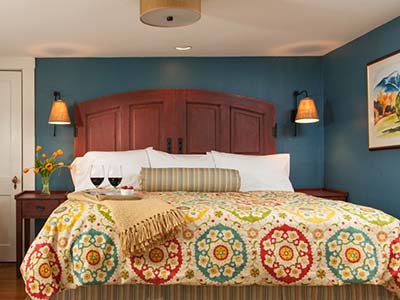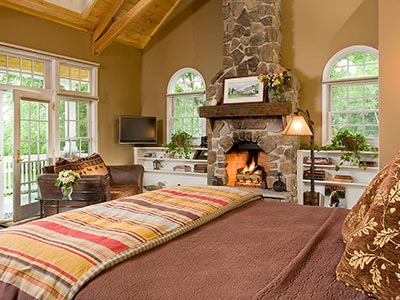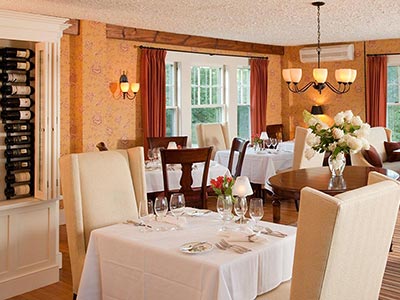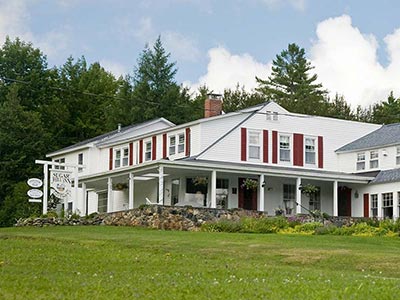Chapter 11 The Art of Innkeeping
It is now a forgotten fact by everyone but me that I once was the dinner chef at the Sugar Hill Inn. As I look back I feel good about how I met the challenge and very pleased that my leaving made way for Executive Chef Val Fortin. Everybody liked my food but they love Val’s even more.
The former owner was the chef and he was leaving upon the closing of the contract. The restaurant served mostly to inn guests on the weekends and didn’t have a strong local following. Being a small restaurant he was the restaurant. May be it wasn’t even really a restaurant, just a country inn dining room. There was no team of assistant chefs or cooks to stay on. The contract called for all food items to be removed and the kitchen to be thoroughly cleaned. We were starting from scratch. Originally we were going to close the contract on a Friday but when I learned that there were guests with dinner reservations I pushed the closing date back to Monday. I was going to need at least a few days to restock the kitchen and prepare for the first diners.
Opening a new restaurant can take months of planning and thousands of dollars. I didn’t have the luxury of time on my side; I had dinner reservations on the books. Besides from the restaurant I had an inn to run. Simultaneously to starting up the restaurant we were doing serious renovations to the inn and replacing an antiquated reservation system.
While I didn’t have answers for everything I did have a vision for my restaurant. We would serve a leisurely dinner in a romantic setting with professional service using quality ingredients prepared fresh with proper technique. To that end I develop a small menu that I felt confident that I could execute with precision and to the highest standards. I was laying a solid foundation for future growth. As the restaurant became busier and I became more experienced, we would build a staff and could grow the menu. Even today we are sometimes criticized for not having enough selection. However a large menu for the small restaurant is always a bad sign.
The White Mountains are not famous for night life. So a great meal follow by a private party back at the room is the night’s entertainment for many guests. That is what fine dining is all about. You need to think about fine dining as something to experience, just like going to the theater. Image a musical with multiple acts building up to a conclusion and sending you home humming. Our four course dinner guides you thru a culinary experience. Add great conversation and wine with someone you love for the perfect night. We have been asked for al la cart many times but we know that it would not deliver the same experience. The other thing that sets apart fine dining is that each dish is a totally composed creation. Broiled salmon on a plate with a choice of vegetables and starch is not fine dining. It is about a composed dish where each element contributes to the whole creation. Asking for the sauce on the side is like asking Van Gough to not use blue paint so that you could add just the right amount yourself. For maximum enjoyment you need to trust the chef.
Having only two choices for each course has the challenge of offering food that is widely enjoyed without appealing to the lowest common denominator. I was determined that everything must be made from scratch, beautifully presented, with layers of flavor and every course must be special and each dish executed with proper technique and precision. Although I have not been the chef in over seven years so much of the basic concepts and principles have endured.
Below is one of my first menus.
Four Course Prix Fixe
May 2006
Dinner Menu $45
Appetizers
Ten Spice Barbecue Shrimp Cocktail
with Roasted Corn – Jicama Salsa and Crispy Tortilla Strips
Home Made Porcini Mushroom Agnolotti
Ravioli from the Piedmont region of Italy served with Sage Butter
Spring Salads
Warm Goat Cheese Salad
Basil and Arugula Salad with Melting Tomatoes
The Arugula is grown in Sugar Hill at Turtle Ridge Farm
And the Basil is from our garden
Entrées
Pan Seared Salmon with Crispy Skin
Served on a bed of sautéed Baby Spinach with Beurre Blanc Sauce
Steak Au Poivre
A Filet Mignon Steak Served with a Pepper Corn Cognac Sauce
And Rosemary New Potatoes from Turtle Ridge Farm, Sugar Hill
Desserts
Home Made French Apple Tart
with Vanilla Bean Ice Cream
Warm Chocolate Brownie
with Cherries, Vanilla Bean Ice Cream and Brandy sauce
Coffee or Tea
Appetizers
A traditional shrimp cocktail is boring. So 1965! But adding my ten spice mix and sautéing in the shell to impart flavor and the roasted corn and Jicama Salsa made it unique and complete. It was plated in a margarita glass and garnished with crispy tortilla strips for height and visual effect.
The alternative, Home Made Porcini Mushroom Agnolotti was also a big hit. The pasta was light and delicate. In a four course dinner it is important for the early courses to create anticipation and not overwhelm later courses.
Spring Salads
In many restaurants the salad course is free with any entrée and very little thought goes into it. I think that the salad course should be as special and tasty as any other course. At this point I don’t remember the exact details as to the greens but I never forget the goat cheese. Picture a slice of the best French bread you can find with local goat cheese on top and put under the broiler until golden. The other salad was made special by the warm roasted cherry tomatoes and local basil and the arugula was grown in Sugar Hill.
Entrées
Salmon frequently when served out is over cooked and boring and ordered as the healthy alternative to what you really want. My salmon had this wonderful crisp skin and was served on a bed of baby spinach with Beurre Blanc Sauce. For perfection make sure the raw fish is completely dry and generously salt the flesh of the fish but never the skin. Add oil to a sauté pan and watch careful for the first hint of the oil smoking and add the fish skin down. If the pan is not hot enough the fish will stick and you will have a mess. As the fish releases the fat from under the skin lower the heat a bit. When the skin is crisp flip the fish and place in the oven for a few minute. The fish will emerge from the oven cooked to perfection.
To make the Beurre Blanc sauce reduce ½ cup dry white wine and ¼ cup white-wine vinegar with a tablespoon of finely minced shallots down to a couple of tablespoons. Reduce heat and slowing stir in cold butter a little bit at a time. If you do it right you will have a wonderful white sauce if not it will be just a pot of melted butter.
Everyone loved the Filet Mignon. Just like today we bought the whole tenderloin and hand cut and tied our steaks. Many people tell us that it is the best beef they have ever tasted. I love French cooking and it’s the sauces that make everything so delicious. The foundation of most French sauces is veal stock. While Chef Val has change the finishing sauce over the years, the under lying veal stock is the same. Very few restaurants still make their own stocks. This is something that we have always done. The process begins by roasting veal bones. Add the roasted bones, mirepoix (onions, carrots, celery), bouquet garni (mixture of herbs), chopped tomatoes, tomato paste, garlic and water to a stock pot and simmer 8 to 12 hours. There are a few more steps but that is the general idea.
The potatoes and arugula were grown in Sugar Hill at Turtle Ridge Farm and the Basil was from our garden. While this was long before we were “certified local” or were a member of the Farm to Restaurant Connection we instinctually focused on serving local when possible.
Dessert
No dinner is complete without dessert. The beauty of a Prix Fixe menu that it sets a pace that allows most guests to reach the promise land of desserts. In my book a dessert menu that features both a chocolate and apple dessert is always a winner.
Many years earlier while a student and visiting Paris I discovered the perfect apple tart. For years I search for an apple tart as perfect as I remembered without success. At the French Culinary Institute not only did I rediscover that tart, I learned how to make it. There are three simple steps that need to be executed with precision. (1)The dough is made in the traditional method of cutting ice cold butter into flour. A food processor makes this task easy. Add a little bit of ice water with the machine running and dough will form. Wrap in plastic wrap and chill before rolling out and fitting the tart pan. It’s very important to dock the shell all over with a fork. (2)An apple compote layer is added on top of the shell. It is very important that all the moister has been cooked out of the compote. (3) Next with perfection, thinly slice the apples and artistically arrange, overlapping on top of the tart. Brush with butter and bake until golden.
The warm liquid center made the brownies very decadent. Some people call these lava cakes. A rich ice cream will add to the enjoyment. I recommend venturing beyond vanilla.
Fortunately the dinners were well received. One guest that was hosting a graduation dinner for their daughter was concerned that the old chef was no long at the inn. I said that I understood and if they wished to cancel it would be ok. They chose not to cancel and afterwards told me how happy they were with everything. Another guest told me confidentially that we were not charging enough for a meal of this quality.
On days that we had guests for both breakfast and dinner I would arrive at the inn no later than 7am. To be ready for our 8am breakfast I would need to be sure that both the muffins and bacon were in the oven no later than 7:30. After breakfast I would start making the desserts and doing the other necessary prep work. It was important to plan carefully so that everything was ready by 5pm. At that time I would clean my station and organize everything (Mise en Place) I would need for the dinner service. By the time the last order went out it was a long day. In many ways professional cooking is like a sport. It is fast paced, requires total focus and strategy to keep everyone happy and making it to the finish line. On days I was cooking it was up to the assistant innkeeper to run the inn. Being the dinner chef was a full time job.
I have to say I did enjoy being the chef but it was not sustainable. Innkeepers in general are a talented group and many feel that there is no job they can’t do and feel the financial pressure to do everything themselves. Those are the inns that are for sale in three years. They are burnt out and they did not build the team required for long term growth. So I decided to fire myself as chef and focus on the big picture. At about the same time I also fired myself as the head bookkeeper. These decisions lead to building the team that would totally transform the inn.
Want to know more? Read our book “Sugar Hill Inn Art of Innkeeping.” Available from Amazon and Barnes and Noble.











